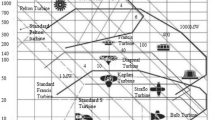Abstract
The sinkage of a moving tracked mining vehicle is greatly affected by the combined compression-shear rheological properties of soft deep-sea sediments. For test purposes, the best sediment simulant is prepared based on soft deep-sea sediment from a C-C poly-metallic nodule mining area in the Pacific Ocean. Compressive creep tests and shear creep tests are combined to obtain compressive and shear rheological parameters to establish a combined compressive-shear rheological constitutive model and a compression-sinkage rheological constitutive model. The combined compression-shear rheological sinkage of the tracked mining vehicle at different speeds is calculated using the RecurDyn software with a selfprogrammed subroutine to implement the combined compression-shear rheological constitutive model. The model results are compared with shear rheological sinkage and ordinary sinkage (without consideration of rheological properties). These results show that the combined compression-shear rheological constitutive model must be taken into account when calculating the sinkage of a tracked mining vehicle. The combined compression-shear rheological sinkage decrease with vehicle speed and is the largest among the three types of sinkage. The developed subroutine in the RecurDyn software can be used to study the performance and structural optimization of moving tracked mining vehicles.
Similar content being viewed by others
References
Bekker M G. 1969. Introduction to Terrain-vehicle Systems. University of Michigan Press, Michigan, USA.
Caccia M, Indiveri G, Veruggio G. 2000. Modeling and identification of open frame variable configuration unmanned underwater vehicles. IEEE Journal of Oceanic Engineering, 25 (2): 227–240.
Chen F, Gui W H, Wang S P, Shen D Y, Han X Y. 2004. Modeling and simulation of a deep seabed tracked vehicle. Robot, 26 (6): 510–514. (in Chinese with English abstract)
Chen G Q, Yi L, Chen S L, Huang H J, Liu Y X, Xu Y H, Cao J R. 2013. Partitioning of grain-size components of estuarine sediments and implications for sediment transport in southwestern Laizhou bay, China. Chinese Journal of Oceanology and Limnology, 31 (4): 895–906.
Dai Y. 2010. The Modeling Research and Simulation Analysis on the Single-rigid-body of Tracked Miner Moving on the Seafloor. Central South University, Changsha, China. (in Chinese)
Gigler J K, Ward S M. 1993. A simulation model for the prediction of the ground pressure distribution under tracked vehicles. Journal of Terramechanics, 30 (6): 461–469.
Han Q J. 2014. Slip and Path Tracking Control of the Deep Sea Tracked Miner. Central South University, Changsha, China. (in Chinese with English abstract)
Janosi Z, Hanamoto B. 1961. The analytical determination of drawbar pull as a function of slip for tracked vehicles in deformable soils. In: Proceedings of the ISTVS 1st International Conference on Mechanics of Soil-Vehicle System. Edizioni Minerva Tecnica, Turin, Italy. p.707–736.
Letherwood M D, Gunter D D. 2001. Ground vehicle modeling and simulation of military vehicles using high performance computing. Parallel Computing, 27 (1-2): 109–140.
Li L, Li S L. 2010. Simulation and mechanical characteristics of terra-mechanics of the surface soil on deep-sea bed. Engineering Mechanics, 27 (11): 213–220. (in Chinese with English abstract)
Lin Z H, Li X L, Cronan D S, Hodkinson R A. 1991. Compositional variations in manganese nodules collected from the North Penrhyn Basin. Chinese Journal of Oceanology and Limnology, 9 (4): 347–357.
Lv D, He J S, Liu S J. 2004. Current study status of exploiting technology to deep-ocean resource. Mining & Processing Equipment, (9): 6–9. (in Chinese)
Ma W B, Rao Q H, Li P, Guo S C, Feng K. 2014a. Shear creep parameters of simulative soil for deep-sea sediment. Journal of Central South University, 21 (12): 4682–4689.
Ma W B, Rao Q H, Wu H Y, Guo S C, Li P. 2014b. Macroscopic properties and micro structure analyses of deep-sea sediment. Rock and Soil Mechanics, 35 (6): 1641–1646. (in Chinese with English abstract)
Ma W B, Rao Q H, Xu F, Feng K. 2016. Impact compressive creep characteristics of simulative soil for deep-sea sediment. Marine Georesources & Geotechnology, 34 (4): 356–364.
Pan J Z. 1986. The general rheological model of paddy soils in south china. Journal of Terramechanics, 23 (2): 59–68.
Rao Q H, Wang Z, Liu S J, Fang M. 2009. Interaction of fluidsolid coupled flexible hose and mining machine in deepocean mining system. In: Proceedings of the Eighth ISOPE Ocean Mining Symposium. International Society of Offshore and Polar Engineers, Chennai, India. p.263–269.
Schiffman R L. 1961. Analysis of the displacements of the ground surface due to a moving vehicle. In: Proceedings of the First International Conference on Mechanics of Soil Vehicle Systems. Turin, Italy. p.45–62.
Schulte E, Handschuh R, Schwarz W. 2003. Transferability of soil mechanical parameters to traction potential calculation of a tracked vehicle. In: Proceedings of the 5th ISOPE Ocean Mining Symposium. International Society of Offshore and Polar Engineers, Tsukuba, Japan. p.123–131.
Shen J, Yu Q. 1989. Pressure-sinkage-time equation for wet soil. Transactions of the Chinese Society f or Agricultural Machinery, 20 (4): 15–19. (in Chinese with English abstract)
Wong J Y. 2001. Theory of Ground Vehicle. 3 rd ed. John Wiley & Sons, New York, USA.
Acknowledgement
The authors would like to thank the National Natural Science Foundation of China for financial support, and the State Key Laboratory of Exploitation and Utilization of Deep Sea Mineral Resources (Joint Lab of Central South University and Changsha Research Institute of Mining and Metallurgy) for technical support.
Author information
Authors and Affiliations
Corresponding author
Additional information
Supported by the National Natural Science Foundation of China (Nos. 51274251, 11502226)
Rights and permissions
About this article
Cite this article
Xu, F., Rao, Q. & Ma, W. Predicting the sinkage of a moving tracked mining vehicle using a new rheological formulation for soft deep-sea sediment. J. Ocean. Limnol. 36, 230–237 (2018). https://doi.org/10.1007/s00343-018-6344-1
Received:
Accepted:
Published:
Issue Date:
DOI: https://doi.org/10.1007/s00343-018-6344-1




